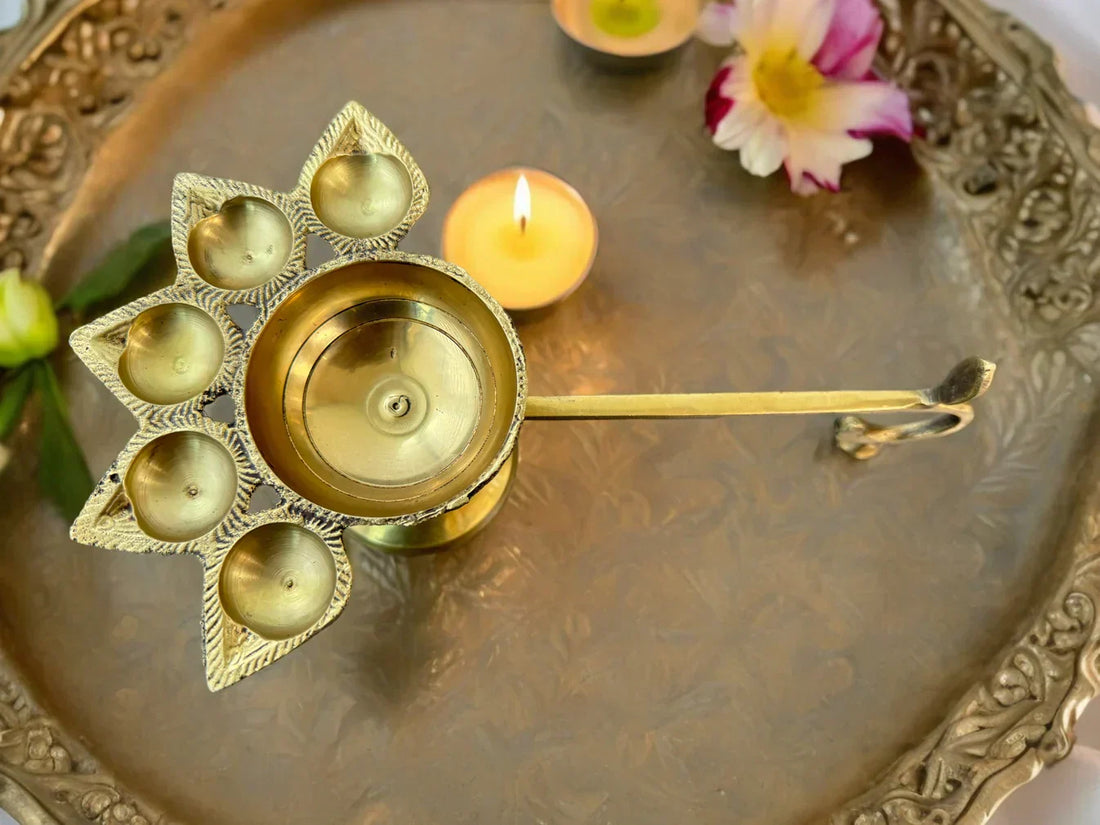Some customs don't fade away with distance. They burn brighter, especially when carried across oceans and generations.
To Indians abroad, festivals are more than calendar events—they're loving reminders of identity, connection, and celebration. And at the center of almost every Indian celebration is a simple, glowing symbol, the diya lamp. Whether a solitary oil lamp for pooja, a cluster of decorative diyas for Diwali, or a tall, regal samai diya at the entrance of a get-together, the act of lighting a diya conveys profound emotional, religious, and cultural meaning.
Whether it is Diwali diya decorating ideas, lighting up contemporary balconies, or a simple oil lamp for pooja glowing quietly in a cozy corner of a home, these oil lamps are silent keepers of culture and bonding. They speak stories of tradition, festivity, and affection—stories we grew up with and now pass on in our way.
The Symbolism of Diya and Samai in Indian Culture
Lighting a diya in Indian tradition is not just a matter of aesthetics—it's a spiritual connection. A diya lamp represents the victory of light over darkness, knowledge over ignorance, and good over evil. It brings peace, prosperity, and purity into the house and soul.
Samai, on the other hand, is a tall metal lamp—often with several wicks—used in religious ceremonies, weddings, and other sacred occasions. Unlike smaller diyas, the samai represents grandeur and is typically used in temples or formal rituals. It stands tall, almost like a guardian of tradition, emitting light and respect.
These ancient practices are deeply rooted in the belief that fire is a purifier and a source of divine energy. Lighting a diya lamp, an oil-filled vessel, isn't just part of a ritual—it's a way of invoking positivity and inner light.
The Emotional Power of a Simple Flame
The act of lighting a puja diya lamp or a samai connects generations. We recall our mothers or grandmothers lighting the evening lamp, reciting prayers, and creating rangoli. For most of us now settled abroad, that one flame evokes an entire ambiance of warmth, prayer, and family bonding.
In this fast world, these rituals are a moment of stillness. Spending a few minutes lighting the oil lamp for pooja in the morning or evening can be an experience of feeling rooted—a daily return to one's roots.
It becomes even more significant when passed on to the next generation. Educating children about how to light a diya lamp, telling them what it means, and engaging them in Diwali diya decoration ideas is how we carry on the heritage of culture and values.
Diyas and Samai Across Indian Festivals
Lighting a diya is something completely comforting. That soft light, the warmth, the stillness—more than merely a tradition. It's a moment of belonging. You can be in the midst of an Indian city or a cozy flat halfway across the world, but lighting that little flame brings you home.
Diwali—The Festival of Lights
The most well-known festival we connect with diyas is, naturally, Diwali. It is commonly known as the Festival of Lights for a reason. Houses are decorated with sparkling sets of diyas—on staircases, balconies, verandas, and even floating in water-filled bowls.
Historically, it symbolizes the triumph of light over darkness and good over evil. But to all of us today, it also symbolizes bringing warmth into our homes and hearts. From brass diyas to floating lamps and hanging designs of today, Diwali diya decoration ideas have changed yet maintain their essence.
Navratri—Nine Nights of Devotion
In most Indian homes, a samai diya is lit on the first day of Navratri and continuously kept lit for the entire nine days. It's not only a light—it's the living presence of the Goddess in the house.
That one flame becomes the spiritual centre around which prayers, songs, and festivities take place. It's a lovely way to indicate devotion and establish a sacred environment.
Weddings—A Sacred Beginning
Lighting the lamp is not merely a religious ceremony—it's an emotional ceremony. In Indian weddings, usually it is the most elderly lady of the family who lights the lamp, blesses the marriage, and wishes divine blessings upon the couple's life.
That radiant samai stands tall throughout the ceremony, witnessing vows, smiles, and the start of a brand-new life. It's such tiny yet powerful traditions that make Indian weddings meaningful.
Karthika Deepam—The Light of Knowledge
In South India, Karthika Deepam is a light festival—hundreds of oil lamps glowing in front of houses and temples. The philosophy is simple but deep: light removes obstacles and brings wisdom, peace, and clarity.
Families come together to light the lamps, illuminating peaceful streets like rivers of gold. It's a sight that fills the heart with peace and wonder.
Keeping Traditions Alive—Wherever You Are
Being away from India can at times make one feel disconnected from one's roots. But it's usually the tiniest rituals, such as lighting an evening diya, adorning a corner with flowers, or putting up a samai during a festival, that ground us.
These are not mere decorative acts rather statements of identity. They're the way we tell stories to our kids, preserve traditions, and remain emotionally linked to where we're from.
So ignite that flame, even if you're miles away. Let it be a reminder that home is not only a location—it's an emotion, one you can replicate wherever you happen to be.
Ignite the Flame of Heritage with Desi By Dil
Seeking diya lamps that blend tradition and sophistication? In need of an authentic oil lamp for pooja or a regal samai diya that speaks of your heritage?
We at Desi By Dil bring India to your doorstep. Be it celebrating Diwali, preparing your puja room, or simply seeking to have a piece of home near you, you're welcome to our lovingly crafted collection, created with love for hearts like yours.
Browse now and rediscover your traditions—one flame at a time.

